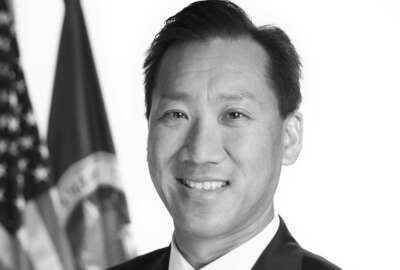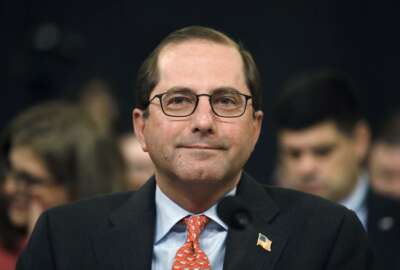

The Health and Human Services Department has 37 specific plans under its broad initiative to maximize talent and create a 21st century workforce.
Best listening experience is on Chrome, Firefox or Safari. Subscribe to Federal Drive’s daily audio interviews on Apple Podcasts or PodcastOne.
The Trump administration’s charge to develop a 21st century workforce comes with a big opportunity for government’s human resources specialists.
That’s the message the Health and Human Services Department brought to its HR specialists Tuesday, when the agency’s leadership shared the detailed vision behind its “Reimagine HHS” initiative at the first-of-its-kind HHS HR Clinic at the National Institutes of Health in Bethesda, Maryland.
“Reimagine HHS” is the department’s attempt to respond to current challenges in the health care industry and align the agency to better respond to and handle those demands, Christine Major, deputy assistant secretary for human resources, told the agency’s HR specialists Tuesday.
It’s also part of HHS’ plan to align with the President’s Management Agenda, which the Trump administration unveiled in more detail last month.
“I view this as an opportunity for us,” Major said in an interview with Federal News Radio. “HR often get[s] all the complaints. People didn’t get paid. There was a problem trying to get the right person in the job. We always hear that. … I do feel like what we did at HHS is take something like that and turn it into something that can be positive.”
The department brought more than 200 of its senior executives together last spring to develop the “Reimagine HHS” concept, which former Secretary Tom Price had introduced in a town hall with employees in May.
In crafting “Reimagine HHS” further, the department’s career leaders next identified six strategic “shifts,” or key initiatives that one executive will lead and champion.
For Major, she’s leading HHS’ goal to maximize talent within an agency of more than 85,000 employees. She and HHS’ other HR directors plan to sit on an executive council to oversee the goal, which alone has five main pillars and 37 different work streams.
The five pillars beyond HHS’ goal to maximize talent are:
Major and her fellow HR directors say they’re not focusing all of their attention at once on all 37 work streams. Instead, they’ve picked a few that they’re focusing on more intently now.
“We have a lot of things in the works that we’re trying to do, but we have to really get policies and processes in place to do it with an agency as large as ours,” Major said. “But we’re excited about that. All of it is underpinning in our IT systems. If we can’t get our IT and our data in a better place, then we’re not going to be able to do a lot.”
Improving performance management — already a key goal within the Trump administration — is one of those initiatives that’s getting more attention from Major and her team now.
Major said it’s an attempt to shift the low marks she sees in HHS and across government on a specific question in the Federal Employee Viewpoint Survey (FEVS): “In my work unit, steps are taken to deal with a poor performer who cannot or will not improve.”
Federal employees at large have typically given their agencies low marks for this question. In 2017, just 31 percent of employees said their agencies were dealing with poor performers, up slightly from 2016’s 29 percent positive response.
HHS so far has held performance management training for supervisors to review best practices for writing a good performance plan, Major said.
“At the end of the day, if you don’t have a good performance plan, if you don’t communicate expectations, then that’s not going to work out,” she said. “So we’re really trying to focus on starting from the beginning, so that both the employee and the manager have a good idea of what’s expected on both ends. We have written a new … guide on managing unacceptable performance, and how do you manage the unacceptable performance so that it doesn’t go on forever and it doesn’t just get shifted into a different room.”
The new performance management guide, Major said, does suggest supervisors consider shortening the time they might use to put an employee on a performance improvement plan.
“It’s not specific, so it’s not an instruction,” she said of the guide. “It’s not a policy. But it does outline time frames and the expectation is that performance improvement plans will be shorter. The shortest amount of time that we believe that an employee could demonstrate improvement. There’s a suggestion that 30 days is a good enough time, depending on the complexity of the position.”
The agency is also hosting manager round tables, so supervisors can talk through challenges together.
“Employees out there want something to be done with people who don’t perform,” Major said. “At the same time, when we say we’re focused on accountability, I do worry that there’s a perception that we’re trying to fire everybody.”
In addition, the department has a small team looking at possible changes it can make to current HR statute and regulations. The legislative team is meeting with each of HHS’ HR centers to discuss their subcomponent’s current challenges and ideas they can bring to Congress.
“We can only do so much,” Major said. “We’re continually asked to do more, do better, do faster [and] do cheaper, but at the end of the day, we’re still tied to a lot of the rules and regulations that haven’t changed.”
The regulations behind veterans preference, Major said, is one example where the department sees the possibility for legislative change.
“I believe very much in veterans preference,” Major said, acknowledging that the topic can be complex and often controversial. “It’s the ‘how.’ If there was any way to do it so that veterans get preference in certain ways. … We’re looking at how can we maximize programs at HHS that really fit veterans well.”
The HHS HR community also identified possible areas where the department could use shared services, but Major said the HR staff is still collecting data to analyze what services might bring the greatest return on investment.
For example, the department’s HR team is considering a shared service solution to support its complex overseas hiring and family support program for employees working abroad, Major said.
Employee engagement has and will continue to be a priority for HHS. The department rose to the second spot among large agencies on the 2017 FEVS.
HHS conducted a short engagement survey of its employees back in January, and the results are still trending in a positive direction.
“We scored really high,” Major said. “Employees are pretty engaged, and we were very impressed with that. How do we maximize off that? How do we keep building what they love about their work?”
Copyright © 2025 Federal News Network. All rights reserved. This website is not intended for users located within the European Economic Area.
Nicole Ogrysko is a reporter for Federal News Network focusing on the federal workforce and federal pay and benefits.
Follow @nogryskoWFED



